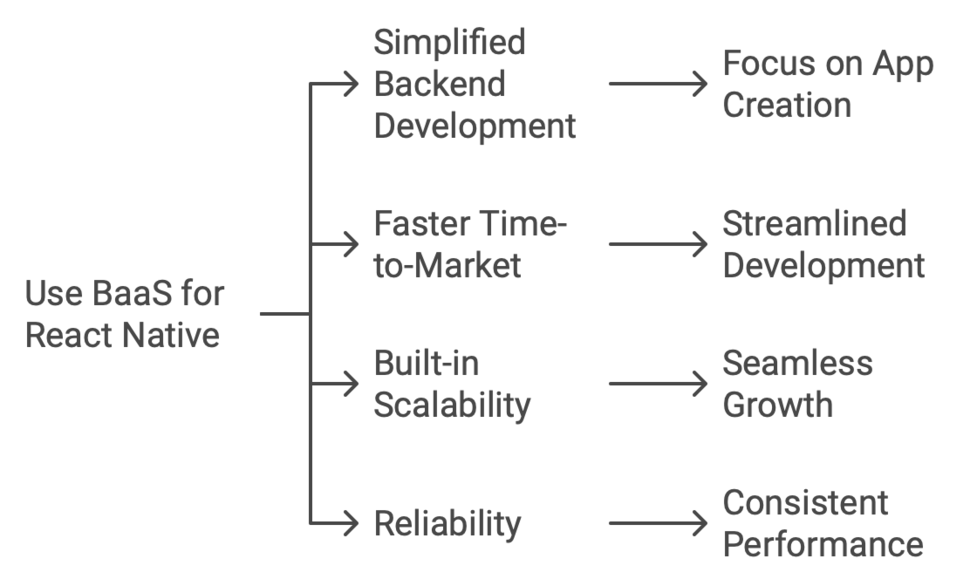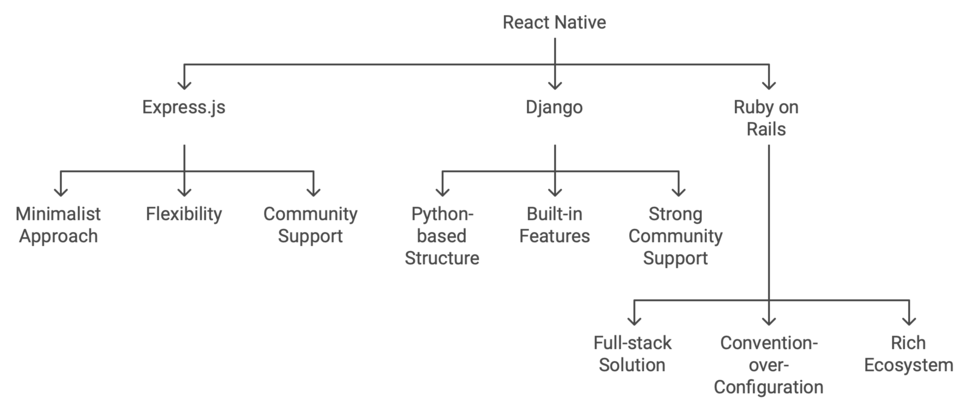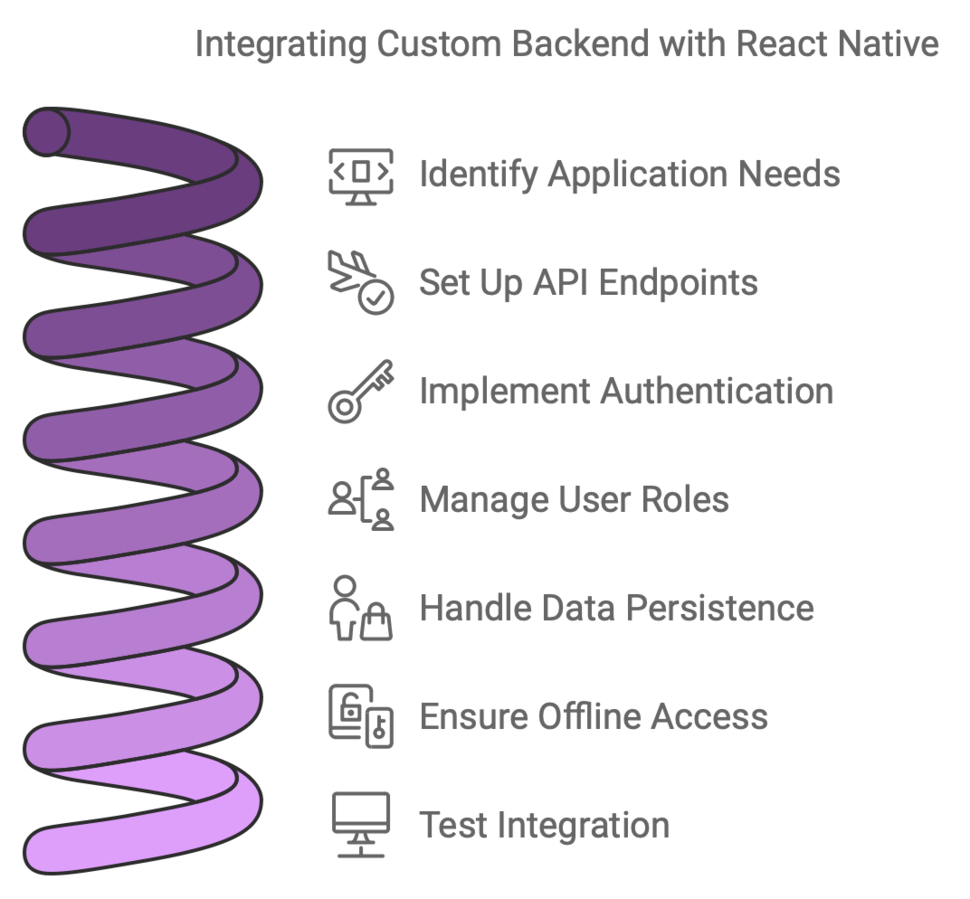What Are The Best Backend Options for React Native App Development?
When developing ReactNativeapps, you must choose the right backend. It is crucial for peak performance and functionality. Firebase is a strong contender for the best backend for React Native apps. It has real-time databases and easy integration with other Google services. Its comprehensive features meet various app needs, from user auth to cloud storage.Node.js provides flexibility for developers who prefer custom back-ends. Node.js has a non-blockingarchitecture. It allows for efficient data processing. It can handle many simultaneous connections with ease. Parse Server shines in the open-source arena, giving you control without sacrificing power. Its ideal for those wanting custom solutions. They want to use established tools like push notifications and analytics.
AWS Amplify simplifies deploying serverless applications with built-in security features. This option is perfect if you rank scalability alongside reliable service management. Each option offers unique benefits for different project needs. They can enhance your React Native development experience.
Firebase: A comprehensive backend solution for React Native
Firebase stands out as a leading backend solution for ReactNative application development. It gives developers a strong infrastructure. They dont need to manage servers or databases. With Firebase, you can focus on UX, not backend issues. One of its standout features is real-time database capabilities. It lets your app sync data across all devices. This boosts interactivity and user engagement.
Firebase offers easy integration with various authentication methods. So, it is simple to install secure login features. Firebases extensive suite includes cloud storage and analytics tools. They allow developers to check performance metrics and store media, hassle-free. Its scalability means that, whether youre starting a small project or ramping up for millions of users, Firebase will adapt.
Node.js: Building custom backend for React Native apps
Node.js gives developers a great platform. They can use it to build custom backends for React Native apps. Its non-blocking design ensures high performance. Your app can handle many requests at once, without lag. With JavaScript as the core language, Node.js creates a seamless development experience.
Developers can use the same language for both front-end and back-end work, streamlining the development process. This reduces context switching and boosts productivity. Node.js is a popular backend choice for React Native apps, offering a robust and versatile backend platform. Integrating third-party services and databases becomes simpler with Node.js. This adaptability lets you scale your app as user demands change. Use its vast ecosystem of libraries and tools to help you create dynamic mobile experiences. While ReactJS is frontend or backend, Node.js serves as a powerful backend tool for React Native apps, making it a complete development solution.Parse Server: An open-source backend framework for React Native
Parse Server is a top open-sourcescalable backend for ReactNative apps. Its rich features empower developers to build robust apps. They can do this without managing traditional server setups. One of its appealing aspects is the ease of use. It can easily react native include cloud functions.Parse Server simplifies common tasks like user authentication, data storage, and real-time notifications, providing a solid backend infrastructure. This lets developers focus on creating great UX. They wont have to worry about backend details. The community support behind Parse is impressive.
Regular updates ensure that it stays relevant with modern development practices. The modular design makes it easy to add or customize services for specific project needs. Scalability is another strong point. Parse can adapt to any app. It can scale up to handle millions of users. Its flexibility opens doors for innovative solutions in various domains.
How to Choose The Right Backend Service for your React Native Development ?
Choosing the best backend service for your React Native application is crucial. Several key factors must be considered. First, assess your projects specific needs. Each app has unique requirements based on its functionality and target audience. Next, scalability plays a crucial role. As your user base grows, ensure the backend can handle the higher traffic. It must not lose performance. Database options are another important factor. Consider if you need real-time capabilities. Or, will a traditional database suffice? Security cannot be overlooked either.
Test authenticationmethods and encryptionstandards to protect user data effectively. Think about ease of seamless integration with React Native features. A smooth link between the front-end and back-end boosts the apps speed.
Evaluating scalability and performance requirements
When developing a ReactNative app, evaluating scalability and performance is crucial. Your choice of backend must accommodate future growth seamlessly. Consider usertraffic patterns and potential spikes in activity. A solution that handles increased loads without lagging will enhance UX.
- Performance Metrics: Response time and data throughput are crucial performance metrics for backend technologies.
- Low Latency: Optimizing for low latency is essential, ensuring quick and responsive interactions with the application. Back-ends should be designed to minimize delays and provide a seamless UX.
Considering database options and real-time capabilities
When developing a ReactNative app, the choice of database is crucial. Different databases offer various features that can significantly impact your applications performance. SQL databases provide structured data storage with strong consistency guarantees. They are ideal for applications requiring complex queries and relationships between entities.
NoSQL options, excel in flexibility and scalability. They handle unstructured data with ease. Real-time functionality is another key consideration. For apps needing instant updates, like chat apps, use WebSockets or similar tech. These allow seamless communication between the client and server.
With real-time capabilities, users experience live interactions without delays. This enhances engagement and satisfaction within your application. Balancing these factors ensures you pick a backend. It must meet current needs and allow for future growth.
Assessing authentication and security features
When developing a ReactNative app, security should always be a top priority. Assessing the authentication features of your chosen backend is crucial. Consider options like OAuth or JWT for managing user sessions. These standards offer robust methods to verify users without exposing sensitive information.
Test how each solution handles password storage and encryption practices. Strong hashing algorithms can protect user credentials from breaches. Dont overlook multi-factor authentication(MFA). This more layer reduces the risk of unauthorized access significantly. Also, analyze security protocols like HTTPS to ensure data in transit is encrypted. A reliable backend will support these measures seamlessly.
What Are The Advantages of Using Backend as a Service (BaaS) for React Native?
Leveraging Backend as a Service (BaaS) for React Native brings many advantages. One major benefit is the simplification of backend dev. Developers can focus on making engaging UIs, not on server management. Time efficiency also stands out. With BaaS, you can speed up your apps time-to-market significantly. Pre-built functionalities allow teams to install features quickly without starting from scratch. Scalability is another crucial aspect. Many BaaS providers offer built-in solutions. They grow with your apps needs. This ensures strong performance during high demand. Reliability is often baked into these services. Most BaaS platforms provide automatic updates and maintenance. This frees developers from infrastructure issues. They can focus on improving their apps usability and features.

Simplified backend development and maintenance
Simplified backend dev is a game-changer for React Native developers. BaaSoptions let you skip server management. You can focus on creating an engaging app.
BaaS platforms give developers instant access to pre-built features. These include auth, database management, and file storage. This means less time spent on setup and more energy directed toward innovation. Maintenance tasks also become streamlined.
Updates and scaling are often handled by the service provider. You wont need to stress about infrastructure issues or downtime; thats taken care of behind the scenes. This shift allows teams to adopt agilemethodologies easily. You can iterate quickly based on user feedback. You wont be bogged down by backend issues. Simplified backend dev lets developers efficiently realize their visions. It keeps the app running well throughout its lifecycle.
Faster time-to-market for React Native apps
Speed is crucial in todays competitive app landscape. BaaS for ReactNative apps speeds up development. Pre-built services let developers avoid the complexities of building infrastructure from scratch. This lets teams focus on core functions and UX, not backend details. A strong backend is essential for any React Native app to functionsmoothly and reliably.- Streamlined Development: Developers benefit from ready-to-use features like authentication, storage, and real-time databases provided by Firebase. These built-in tools streamline processes that would otherwise require significant time and effort to implement independently.
- Time Savings: By leveraging these pre-built tools, developers can save weeks of development time, focusing their efforts on building unique features rather than basic infrastructure.
BaaS solutions are designed with scalability in mind. As your app grows, you wont face bottlenecks associated with traditional back-ends. Instead, you can seamlessly scale resources according to demand without disrupting operations. This agility lets businesses launch their products faster. It also maintains high quality and performance.
Built-in scalability and reliability
Built-in scalability is a game changer for modern app development. A backend solution with this feature will help your app grow. Scalable solutions adapt to your users, whether they grow or fluctuate.
Reliability plays an equally crucial role in maintaining user trust. A dependable backend ensures minimal downtime and consistent performance. This means users can interact with your app without glitches or interruptions. These traits let developers focus on creating great UXs.
They wont have to stress over infrastructureissues. A React Native application needs to scale easily and provide reliable service. This is its foundation. Businesses can innovate and respond to the market with scalability and reliability. They enable apps that meet todays needs. They also evolve with new tech and a growing audience.
How Does The Backend Impact User Experience in React Native Mobile App Development?
The backend plays a crucial role in shaping UX for React Native mobile apps. A well-optimized backend ensures that users enjoy smooth interactions and minimal loading times. When APIs perform efficiently, it significantly enhances the app performance. Real-time features can elevate user engagement. Websockets enable instant communication between the server and client. This makes chats and notifications seamless. Users like updates to happen in real time, without refreshing their screens. Data synchronization across devices is another critical aspect of UX. Consistent data on phones and tablets builds trust with your audience. It makes switching between devices effortless. Time spent on backend development leads to happier users. They are more likely to return to your app.
Optimizing API performance for smooth interactions
APIperformance is key to a smooth UX in ReactNative apps. When users tap on a button or swipe through screens, they expect instant feedback.
- Impact of Slow API Responses: Slow APIresponses can lead to user frustration and diminished engagement, as users experience delays in receiving information.
- Optimization Techniques: To enhance performance, consider implementing caching techniques for frequently requested data. Caching reduces server calls and accelerates loading times, improving UX. Streamlining the communication between the app and backend is vital for optimal performance.
Asynchronous requests boost responsiveness. They let your app work while waiting for the servers data. Implementing pagination can improve UX. It loads only the data needed at a given time. This avoids overwhelming users with too much information at once. Monitoring API response times helps identify bottlenecks that may hinder performance. If developers fix these issues, app interactions will improve. Users will be more satisfied.
Implementing real-time features with websockets
Real-time features elevate the UX by providing instant updates. Websockets play a crucial role in achieving this seamless interaction. Websockets are different from traditional HTTP requests. They keep a constant connection between the client and the server. This allows for two-way communication without the need to constantly re-establishconnections. As a result, data can flow freely in both directions. For instance, chat applications benefit immensely from websockets.
| Aspect | Description |
|---|---|
| Use Cases | Chat apps, live updates, multiplayer games. |
| Advantages | Low latency, persistent connection, efficient data transfer. |
| Connection Protocol | Uses ws:// (insecure) or wss:// (secure). |
| Data Format | Text, binary; JSON is common for structured data. |
| Popular Libraries | Socket.IO (JS), websockets (Python), web_socket_channel (Dart). |
| Security | Use wss:// for encryption; implement token-based auth. |
| Handling Events | Manage onOpen, onMessage, onError, and onClose. |
Ensuring data synchronization across devices
Datasynchronization across devices is crucial for a seamless UX. Users expect their info to be consistent on both mobile and desktop. Implementing real-time databases can simplify this process.
- Real-Time Data Updates: Technologies like Firebase Realtime Database provide instant updates to data across all devices, ensuring users have the most current information without manual refreshes.
- Synchronization Conflict Management: Managing conflicts during synchronization is a crucial aspect to consider when implementing real-time data updates.
Version control tools track data changes and fix issues. They ensure integrity in user interactions. Clear communication with users about syncing processes enhances trust and engagement. Users want to control their appexperience. They dislike not knowing how their data flows between devices.
What are The Top Backend Frameworks Compatible with React Native Backend?
With React Native, the right back-end framework is key to your apps success. Express.js stands out as a minimalist solution. Its built on Nodejs and allows developers to create APIs quickly and efficiently. Django is a robust backend, Python-based structure. It has a great admin panel and many libraries. Its perfect for applications that require complex data handling. Each structure has unique strengths. They let developers customize their apps backend to specific needs and scalability.

Express.js: A minimalist backend framework for Node.js
Express.js is a minimalist back-end framework for Node. It streamlines server-side development. Its lightweight nature allows developers to build robust applications with minimal overhead. One of its key advantages is flexibility.
- Flexibility: Developers can structure their apps as they wish, allowing for creative and innovative coding approaches.
- Community Support: An active community around Vite provides seamless access to resources and support, fostering a collaborative environment.
Django: A powerful Python-based backend option
Django is a strong back-end framework for ReactNative apps. It leverages Pythons simplicity and power. Its high-level architecture allows developers to build secure and scalable web services effortlessly. One of Djangos key advantages is its batteries-included philosophy.
It has built-in features like an auth system, an admin interface, and an ORM. These speed up development. With great docs and strong community support, integrating Django as a backend in React Native is easy. Djangos power and React Natives flexibility enable new, dynamic mobile apps.Ruby on Rails: A full-stack solution for React Native apps
Ruby on Rails, or Rails, is a strong full-stack solution for ReactNative apps. Its convention-over-configuration philosophy streamlines development. It lets developers focus on coding, not on boilerplate. Integrating Ruby on Rails with React Native creates a powerful synergy. The backend can manage complex data and logic.
It serves an API that your mobile app uses seamlessly. Rails has a rich ecosystem of gems and libraries. They enhance its functionality without reinventing the wheel. This means quicker implementations of features like user-authentication or payment processing. Rails also prioritizes developer happiness through clean syntax and strong community support. As you build out your apps server-side components, youll find it easy to maintain and scale as your user base grows. These are just some of the react native advantages of using Rails as a backend for your mobile app.How to Integrate a Custom Backend with a React Native Application?
Integrating a custom backend with your ReactNative application involves several key steps. First, set up your API-endpoints. This will allow smooth communication between the front-end and back-end. Use RESTful or GraphQL APIs based on your apps requirements. Next, install authentication and authorization mechanisms. Use tokens, like JWTs, to secure user data. They grant access only to authenticated users. Data persistence is crucial for enhancing UX. Use libraries like Redux or ContextAPI to manage state. This will ensure smooth interactions across components. Test the integration thoroughly. Check network requests and responses in real-time to catch any issues early on. The choice between cra vs nextjs depends on your specific needs and project requirements.
Setting up API endpoints for React Native consumption
Setting up API-endpoints for ReactNative apps is crucial. It enables smooth communication between the frontend and backend. Start by defining your applications needs. Identify which data you need from the server, like user info or product details.
Next, create RESTful API routes that align with standard practices. Use clear names like `/users` or `/products`. It will help developers on both ends of the app. Use HTTPmethods correctly: GET to retrieve data, POST to create, PUT/PATCH to update, and DELETE to remove. Ensure your APIs return structured responses in JSON format.
This consistency makes data handling in your ReactNative application easier. It also allows for better error handling during interactions.
Implementing authentication and authorization
Authentication and authorization are crucial. They ensure users only access what theyre permitted. Start by choosing a robust method for user authentication, such as JSON Web Tokens (JWT) or OAuth.
Assign roles to users based on their needs: admin or regular user. Then, tailor data visibility accordingly. Session management is key. It keeps your app secure and responsive. Regularly refresh tokens or use short-lived sessions. This will reduce risks from unauthorized access during a users journey in your app. This is a valuable option for React Native development when focusing on user security. The decision between expressjs vs nextjs depends on your specific requirements and priorities.These methods provide secure token-based verification. For ReactNative apps, integrating libraries like Firebase-Authentication simplifies the process. It allows login via email, social media, or phone. This boosts UX while maintaining security. Once authenticated, install role-based access control to manage permissions effectively.
Handling data persistence and state management
Data persistence and state management are vital. They improve the UX in ReactNative apps. Managing the apps state can be tricky, especially as it grows more complex.
Using libraries like Redux or MobX helps simplify this process. They provide clear patterns for managing application state across various components. By doing so, developers ensure consistency in data representation. When building a backend for React Native, there are various approaches to consider.Data persistence matters when users use an app offline or leave it. Local storage solutions, such as AsyncStorage, allow offline access to data. Implementing these strategies not only boosts performance but also enhances responsiveness. This creates a seamless interaction for users, regardless of their connectivity status. With the righttools, data handling becomes intuitive and efficient. It also keeps users engaged.
What Are The Emerging Trends in Backend Solutions for React Native?
The landscape of back-end solutions for React Native is evolving rapidly. One trend gaining traction is the adoption of serverless architectures. This lets developers focus on coding, not server management. It boosts agility. GraphQL APIs are also becoming more popular due to their efficiency in data fetching. Instead of many endpoints, developers can get all data in one query. This simplifies the frontend-backend interaction. These trends show a community eager for innovation in app development. These advancements keep React Native a top choice for powerful mobile apps.

Serverless architectures for React Native backends
Serverless architectures are changing the game for custom React Native backend development. They allow developers to focus on writing code rather than managing server infrastructure. With serverless, you pay only for what you use, making it a cost-effective solution.
Using services like AWS Lambda or Azure Functions, your app can auto-scale based on demand. This flexibility is perfect for apps that experience fluctuating traffic patterns. The approach accelerates development cycles while ensuring that resources are utilized efficiently.
GraphQL APIs for efficient data fetching
GraphQL APIs are changing how we fetch data in ReactNative apps. Unlike traditional REST APIs, GraphQL lets clients request only the data they need. This minimizes over-fetching and under-fetching issues. With a single request, developers can retrieve complex nested data structures efficiently.
Imagine needing user details along with their posts. Instead of making many calls, GraphQL serves everything in one go. Real-time capabilities also shine through subscriptions. They let apps receive updates without polling. Users enjoy dynamic interactions that improve the experience. As more teams adopt this approach, efficiency becomes key for modern app development. To improve their back-ends and UX, users must embrace GraphQL. It may be essential for this.
Microservices-based backends for scalable React Native apps
Microservices-based back-ends are gaining traction in the React Native ecosystem. This approach breaks applications into smaller, independent services. They can communicate over APIs. Each microservice focuses on a specific function, allowing for easier updates and maintenance. If you are building an app, you might want to use react native for its robust mobile app development capabilities. Incorporating microservices enhances scalability. As demand grows, developers can scale individual components rather than the entire application. This flexibility is essential for high-traffic apps where performance is critical. As you explore back-end solutions for your React Native projects, consider the rise of mobile backend as a service (MBaaS) platforms. They should align with your app development goals and your vision for innovation.
